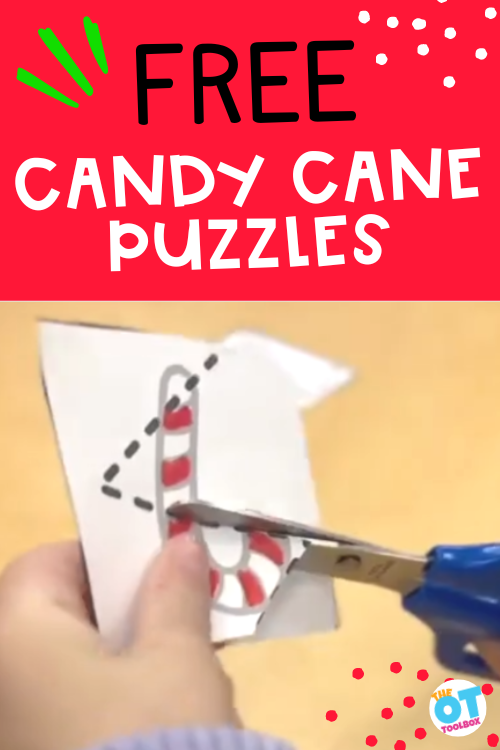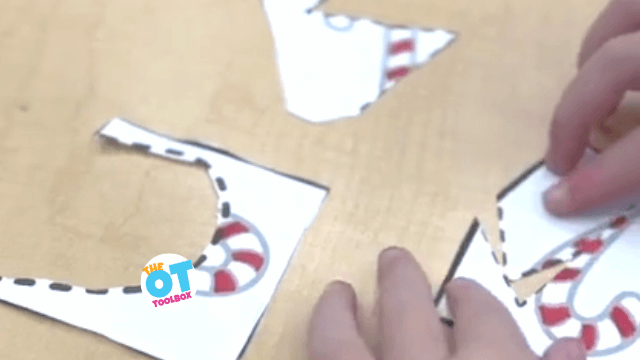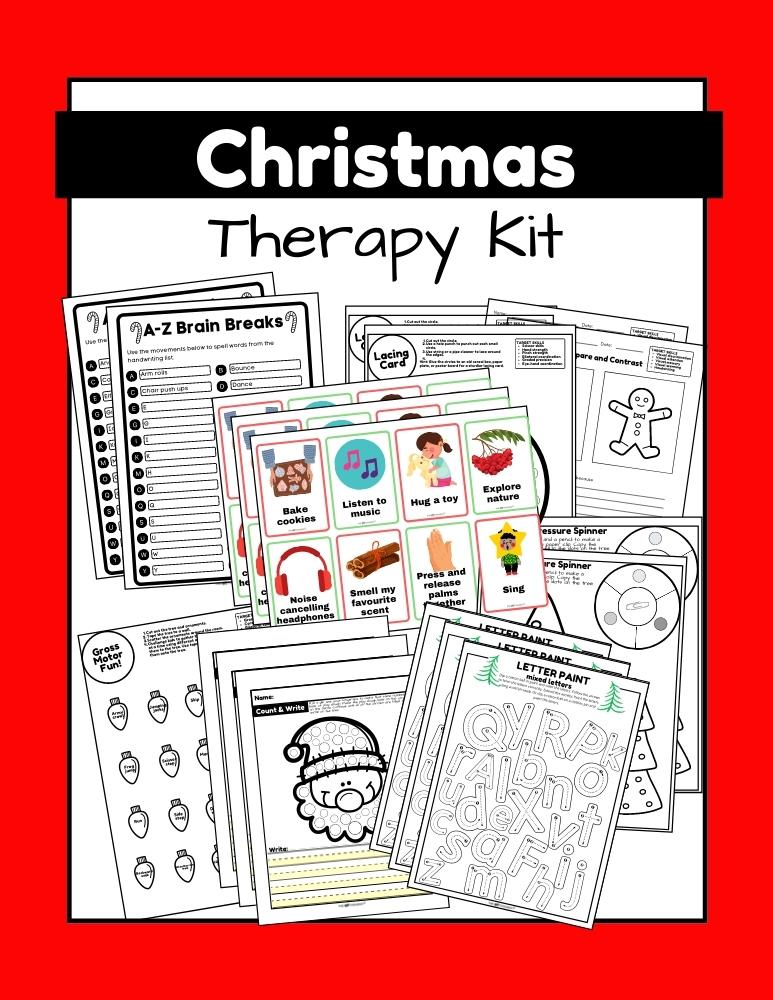Today’s free printable candy cane puzzles are a fun Christmas occupational therapy activity that supports skill-building this time of year. Are you searching for a creative and educational solution to enhance your child’s fine motor skills, eye-hand coordination, scissor skills, and visual perception? Look no further! In this blog post, we’re unveiling the secrets behind free candy cane puzzles and providing you with a free printable PDF to get started.
You could pair these candy cane puzzles with our peppermint moon dough for multisensory play.

Why use mini candy cane puzzles?
We’ve created several versions of these mini puzzles over the years. They are all available inside The OT Toolbox membership club. However, we do have a free version of our pumpkin puzzles here. We love using these mini puzzles for many reasons. It’s a great Christmas fine motor activity and when used in sensory bins, can even be a Christmas sensory activity for this time of year.
Let’s break it down.
The thing is that puzzles are a fine motor learning tool that supports several crucial developmental milestones in children.
Building puzzles in occupational therapy sessions is a fantastic activity that contributes to the development of various underlying skills in individuals, especially in children. Puzzles are a nice way to support carryover of skills at home as well.
Here are some key skills that are enhanced through puzzle-building:
- Visual perceptual skills: Looking for puzzle pieces on a table that fit in a specific space in a puzzle uses skills such as form constancy, visual closure, visual figure ground, visual attention, and visual spatial relationships.
- Problem Solving: Puzzles require individuals to analyze the situation, develop a strategy, and apply logical reasoning to find a solution.
- Critical Thinking: Engaging with puzzles encourages individuals to think critically, evaluate options, and make decisions based on available information.
- Fine Motor Skills: manipulating pieces, pressing puzzle pieces into the space they fit, these tasks support finger isolation, separation of the sides of the hand, coordination, and more.
- Hand-Eye Coordination: Manipulating puzzle pieces and fitting them together promotes the coordination between visual information and hand movements.
- Precision and dexterity: Placing smaller pieces accurately hones fine motor skills, aiding in tasks that require controlled hand movements. Puzzles can sometimes be a tool used in manual dexterity goals in OT.
- Shape Recognition: Sorting and fitting puzzle pieces into specific spaces enhance spatial awareness and the ability to recognize shapes. This is a task that is great for developing skills in letter recognition.
- Visual Discrimination: Distinguishing between colors, patterns, and details in puzzle pieces develops skills needed for distinguishing between letters, numbers, and shapes. These skills include form constancy.
- Visual Memory: Remembering the shapes and patterns of puzzle pieces helps improve short-term and visual memory.
- Pattern Recognition: Identifying recurring patterns in shapes and colors in the puzzle pieces supports memory and cognitive flexibility. Here is more information on the skills used in pattern recognition.
- Collaboration: Working on puzzles with others fosters collaboration, teamwork, and communication skills.
- Turn-Taking: Sharing the activity requires individuals to take turns, promoting patience and social interaction.
- Vocabulary Building: Discussing the puzzle, describing pieces, and talking about the process contribute to the development of vocabulary. This includes Expressive Language (explaining one’s thoughts and strategies during puzzle-solving) and receptive language skills.
- Emotional Regulation: Building puzzles supports several areas of emotional skills including Frustration Tolerance (facing difficulties in puzzle-solving helps individuals develop patience and manage frustration when confronted with challenges.) and Sense of Accomplishment (successfully completing a puzzle boosts self-esteem and a sense of accomplishment).

These underlying skills make puzzle-building a versatile and valuable activity for individuals of all ages, contributing not only to academic readiness but also to overall cognitive, social, and emotional development.
Here is a video we made showing how to use these candy cane puzzles in developing skills:
Print off these free candy cane puzzles and build skills this holiday season!
How to use candy cane puzzles in OT sessions
If using a mini puzzle with a holiday theme seems like a fun way to build skills, you can use the free candy cane puzzles we have here on the site.
- Step 1: Download the free printable PDF with candy cane puzzles.
- Step 2: Color the candy canes to work on visual motor skills. Coloring is a great fine motor task.
- Step 3: Cut out the squares for simple cutting tasks. Then cut on the curved lines.
- Step 4: Build the puzzles by matching the lines to target fine motor skills, eye-hand coordination, scissor skills, and visual perception.
You can use these several ways, including building puzzles by grading the activities. Offer the student just one or two puzzles at a time to make the activity simpler. Or, increase the number of puzzles to sort the different shapes and line forms.
You can also place the puzzle pieces in a sensory bin or in OT obstacle courses to support different skills.
Before diving into this hands-on activity, ensure you have the following:
- Tools: Scissors, printer, and colored markers/crayons. Here are our favorite types of scissors to use to meet different needs with scissor skills.
- Safety: Supervise scissor use to prevent accidents.
- Laminate: You can laminate these puzzle pieces for durability.
Free Candy Cane Puzzles
Incorporating free candy cane puzzles into your child’s routine can be both fun and beneficial. Download the free printable PDF today and witness the transformative impact on your child’s developmental journey. Take a proactive approach to learning through play!
These candy cane puzzles are delivered by email. Enter your email address into the form below and the printable will be delivered to your email inbox. OT Toolbox members can log into their account and access this printable under our Christmas activities.

Colleen Beck, OTR/L has been an occupational therapist since 2000, working in school-based, hand therapy, outpatient peds, EI, and SNF. Colleen created The OT Toolbox to inspire therapists, teachers, and parents with easy and fun tools to help children thrive. Read her story about going from an OT making $3/hour (after paying for kids’ childcare) to a full-time OT resource creator for millions of readers. Want to collaborate? Send an email to contact@theottoolbox.com.
Looking for done-for you therapy activities this holiday season?
This print-and-go Christmas Therapy Kit includes no-prep, fine motor, gross motor, self-regulation, visual perceptual activities…and much more… to help kids develop functional grasp, dexterity, strength, and endurance. Use fun, Christmas-themed, motor activities so you can help children develop the skills they need.
This 100 page no-prep packet includes everything you need to guide fine motor skills in face-to-face AND virtual learning. You’ll find Christmas-themed activities for hand strength, pinch and grip, dexterity, eye-hand coordination, bilateral coordination, endurance, finger isolation, and more.







